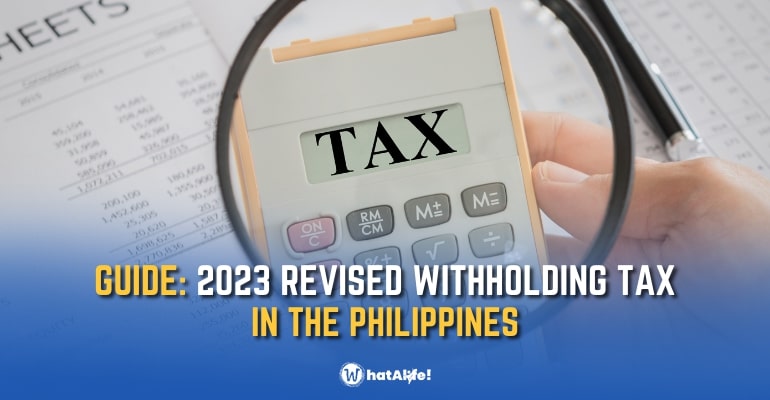With the introduction of a new year also comes the reduction of income tax rates. It’s basically one of the good things that has happened this year so far. The TRAIN Law amended lower income tax collection for individual citizens and foreigners. Check out the 2023 Withholding Tax Table in the Philippines in this blog to see the rate changes.
TRAIN Law and other Tax Reforms
The reduction of withholding tax is all thanks to the TRAIN Law, which was introduced during the Duterte administration. TRAIN Law is the abbreviation for “Tax Reform And Inclusion” – the first part of the four major reforms in the Philippines.
The second tax reform is the Corporate Recovery And Tax Incentives For Enterprises or the CREATE Act, which aims to create more businesses by lowering corporate income tax.
Third is the Real Property Valuation Reform, which is dedicated to creating a more equitable evaluation system for real estate properties. When this reform gets implemented, real estate will become more economical, ensuring that families from all walks of life will have a roof to sleep on.
The last tax reform is the Passive Income and Financial Intermediary Taxation Act. This reform will encourage citizens to invest in stocks, bonds and other passive income sources by having a constant 15% rate on interest income, capital gains and dividends. Moreover, the reform will remove documentary stamps for non-monetary transactions.
These reforms aim to eradicate extreme poverty by 2040 and address inequality in a sustainable manner.
Revised Withholding Tax Table in the Philippines (2023 and Onwards)
| DAILY | 1 | 2 | 3 | 4 | 5 | 6 |
| Compensation Range | ₱685 and below | ₱685 -₱1,095 | ₱1,096 – ₱2,191 | ₱2,192 – ₱5,478 | ₱5,479 – ₱21,917 | ₱21,918 and above |
| Prescribed Withholding Tax | 0.00 | 0.00 +15% over ₱685 | ₱61.65 +20% over ₱1,096 | ₱280.85 +25% over ₱2,192 | ₱1,102.60 +30% over ₱5,479 | ₱6,034.30 +35% over ₱21,918 |
| WEEKLY | 1 | 2 | 3 | 4 | 5 | 6 |
| Compensation Range | ₱4,808 and below | ₱4,808 – ₱7,691 | ₱7,692 – ₱15,384 | ₱15,385 – ₱38,461 | ₱38,462 – ₱153,845 | ₱153,846 and above |
| Prescribed Withholding Tax | 0.00 | 0.00 +15% over ₱4,808 | ₱432.60 +20% over ₱7,692 | ₱1,971.20 +25% over ₱15,385 | ₱7,740.45 +30% over ₱38,462 | ₱42,355.65 +35% over ₱153,846 |
| SEMI-MONTHLY | 1 | 2 | 3 | 4 | 5 | 6 |
| Compensation Range | ₱10,417 and below | ₱10,417 – ₱16,666 | ₱16,667 – ₱33,332 | ₱33,333 – ₱83,332 | ₱83,333 – ₱333,332 | ₱333,333 and above |
| Prescribed Withholding Tax | 0.00 | 0.00 +15% over ₱10,417 | ₱937.50 +20% over ₱16,667 | ₱4,270.70 +25% over ₱33,333 | ₱16,770.70 +30% over ₱83,333 | ₱91,770.70 +35% over ₱333,333 |
| MONTHLY | 1 | 2 | 3 | 4 | 5 | 6 |
| Compensation Range | ₱20,833 and below | ₱20,833 – ₱33,332 | ₱33,333 – ₱66,666 | ₱66,667 – ₱166,666 | ₱166,667 – ₱666,666 | ₱666,667 and above |
| Prescribed Withholding Tax | 0.00 | 0.00 +15% over ₱20,833 | ₱1,875.00 +20% over ₱33,333 | ₱8,541.80 +25% over ₱66,667 | ₱33,541.80 +30% over ₱166,667 | ₱183,541.80 +35% over ₱666,667 |
Annual Tax Table (EFFECTIVE DATE JANUARY 1, 2023)
| Not over ₱ 250,000.00 | 0% |
| Over ₱ 250,000.00 but not over ₱ 400,000.00 | 15% of the excess over ₱ 250,000.00 |
| Over ₱ 400,000.00 but not over ₱ 800,000.00 | ₱ 22,500.00 + 20% of the excess over ₱ 400,000.00 |
| Over ₱ 800,000.00 but not over₱ 2,000,000.00 | ₱ 102,500.00 + 25% of the excess over ₱ 800,000.00 |
| Over ₱ 2,000,000.00 but not over ₱ 8,000,000.00 | ₱ 402,500.00 + 30% of the excess over ₱ 2,000,000.00 |
| Over ₱ 8,000,000.00 | ₱ 2,202,500.00 + 35% of the excess over ₱ 8,000,000.00 |
Frequently Asked Questions
Why is Withholding Tax important?
Tax is the lifeblood of a nation. With withholding tax, it lessens the collection cost of taxes through simplification. In addition, it promotes voluntary compliance, which is the ideal way to maintain the nation’s sovereignty.
Withholding tax helps prevent delinquencies and revenue loss, ensuring that people don’t incur additional charges imposed when missing taxation.
Withholding Tax Classification
Withholding tax has four classifications:
- Compensation – the tax deducted from wages given to individuals under an employer-employee relationship.
- Expanded – is a type of withholding tax on specific income payments and can be applied toward the payee’s income tax liability for the taxable quarter or year in which the payee earned the specific income.
- Percentage Taxes – the tax that national government agencies (NGAs) and their instrumentalities impose before paying non-VAT registered suppliers/taxpayers.
- Value-Added Tax – the tax that national government agencies (NGAs) and their instrumentalities impose before paying non-VAT registered suppliers/taxpayers.
Each tax classification has a varied collection method but is eminently used for the same purpose: to fund the nation’s growth.
Do Minimum Wage Earners Need to Pay Tax?
According to the Bureau of Internal Revenue, statutory minimum wage earners working in private and public sectors are not required to pay the withholding tax. These also include their Holiday pay, Overtime pay, Hazard pay, and Night shift differential.
Closing Remarks
Paying taxes is the responsibility of a nation’s citizens. Without taxes, public infrastructures, utilities and programs are impossible, which can lead to the deterioration of a nation’s quality of life. Even if you’re the nation’s highest-ranking official, paying taxes is still part of your job as a citizen. –WhatALife!/Vaughn
Also read: How to Get Taxpayer Identification Number (TIN) Online in 2022

Leave a Reply